The Ultimate Guide to Buying a Home Flight Simulator PC [2023 Updates]
A high-quality computer is an essential part of any home flight simulator. It is responsible for powering your flight simulation software and supporting the additional flight sim gear that you purchase. That means the computer you choose needs to meet a long list of technical specifications.
Since there are several flight simulator software providers, the requirements vary for a home sim computer. Let’s take a look at the most popular simulation software products and the computer performance required to use each of them.
Microsoft Flight Simulator 2020
The next generation of one of the original simulation franchises, Microsoft Flight Simulator 2020 leverages Bing maps and Azure AI to generate a near-photorealistic 3D world for you to navigate. You can run MSFS 2020 on either a PC or an Xbox game console.
Minimum Hardware Requirements for Microsoft Flight Simulator 2020
Computer Processor - Ryzen 3 1200 or Intel i5-4460
Computer Memory - 8 gigabytes (GB)
Hard Drive Space - 150 GB
Graphics Card Video Memory - 2 GB
Graphics Card Other - Radeon RX 570 or NVIDIA GTX 770
Recommended Hardware for Microsoft Flight Simulator 2020
Computer Processor
-
- Ryzen 5 1500X up to Ryzen 7 2700X
- Intel i5-8400 up to Intel i7-9800X
Hard Drive Space - 150 GB or 150 GB SSD
Graphics Card Video Memory - 4-8 GB
Graphics Card Other
-
- Radeon RX 590 up to Radeon Vll
- NVIDIA GTX 970 up to NVIDIA RTX 2080
Prepar3D v3
Prepar3D is a visual simulation platform from Lockheed Martin that allows users to create aviation training scenarios. It engages flight simulator pilots with immersive environments that also are suited for commercial, academic, professional, or military instruction. Prepar3D can be used to quickly create flying scenarios anywhere in the virtual world.
Minimum Hardware Requirements for Prepar3D v3
Per the Prepar3D system requirements page
-
- N editions require Media Feature Pack
Computer Memory - 2 gigabytes (GB)
Hard Drive Space - 30 GB, with at least 10 GB on C:\
-
- 3 GB for the Software Development Kit
Graphics Card Other - Full DirectX 11 Support
Other -
-
- Administrator Rights (for installation only)
- Microsoft Core XML Services (MSXML) 6.0
- 1024×768 minimum screen resolution for primary display
Recommended Hardware for Prepar3D v3
Computer Processor - Quad-Core Processor @ 3.0 GHz +
Computer Memory - 4 GB +
Hard Drive Space - M.2 or Solid-State Drive is strongly recommended
Graphics Card Video Memory - 4 GB + (GDDR5 or better)
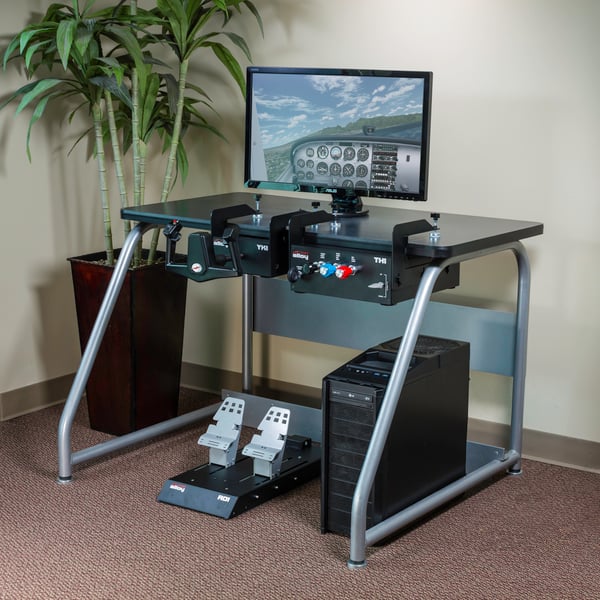
Flying Prepar3D With Redbird Alloy Home Simulator Controls
Prepar3D v4
Lockheed Martin’s Prepar3D v4 includes a comprehensive baseline update to a 64-bit architecture. It includes higher resolution visuals, more objects, increased data precision, and improved performance. Additionally, the release includes a dynamic lighting system, rain and snow particles, global 3D trees and vegetation, a fully reworked software development kit, new default vehicles, and countless core improvements.
Minimum Hardware Requirements for Prepar3D v4
-
- N editions require Media Feature Pack
Computer Memory - 4 GB
Hard Drive Space - 40 GB, with at least 15 GB on C:\
-
- 3 GB for the Software Development Kit
Graphics Card Other - Full DirectX 11 Support
Other -
-
- Administrator Rights (for installation only)
- Microsoft Core XML Services (MSXML) 6.0
- Microsoft .NET Framework 4.7.2
- 1920×1080 minimum screen resolution for primary display
Recommended Hardware for Prepar3D v4
Computer Processor - Quad-Core Processor @ 3.5 GHz +
Computer Memory - 16 GB DDR4/2666MHz +
Hard Drive Space - M.2 or Solid-State Drive is strongly recommended
Graphics Card Video Memory - 8 GB + (e.g. NVIDIA GeForce GTX 1080 Ti)
Prepar3D v5
Released in April 2020, Prepar3D v5 was built to address next generation training needs. The new platform prioritizes the latest graphics technologies, which enhance weather and water visuals. Lockheed Martin updated the entire global database and improved the details at more than 24,000 airports to expand the training possibilities of pilots.
Minimum Hardware Requirements for Prepar3D v5
Computer Processor - Quad Core @ 3.0 GHz
Computer Memory - 4 GB
Hard Drive Space - 60 GB, with at least 35 GB on C:\
-
- 3 GB for the Software Development Kit
- M.2 or Solid State Drive (SSD) is strongly recommended
Graphics Card Other - DirectX 12 with feature level 12_0 or greater
Other -
-
- Administrator Rights (for installation only)
- Microsoft Core XML Services (MSXML) 6.0
- Microsoft .NET Framework 4.8
- 1920×1080 minimum screen resolution for primary display
Recommended Hardware for Prepar3D v5
Computer Processor - Octa Core @ 3.7 GHz +
Computer Memory - 16 GB DDR4/2666MHz +
Hard Drive Space - 60 GB, with at least 35 GB on C:\
-
- 3 GB for the Software Development Kit
- M.2 or Solid State Drive (SSD) is strongly recommended
Graphics Card Other - DirectX 12 with feature level 12_0 or greater
Other -
-
- Administrator Rights (for installation only)
- Microsoft Core XML Services (MSXML) 6.0
- Microsoft .NET Framework 4.8
- 1920×1080 minimum screen resolution for primary display
X-Plane 10
X-Plane 10 provides realistic flight modeling right on your desktop. It is a flexible flight simulator with thousands of compatible add-ons. There are endless territories and aircraft to explore.
X-Plane 10 features a scenery engine for all three platforms, Windows, Mac, and Linux; which includes a uniform lighting system 'that lights a plausible world.’ Created from many real-world databases, the roads and build-up areas appear as they would in real life.
Minimum Hardware Requirements for X-Plane 10
Per the X-Plane 10 system requirements page
-
- The X-Plane Knowledge Base specifies that X-Plane 10 does not support PowerPC-based Macs or versions of OS X that predate 10.6.8
- X-Plane 10 also is not compatible with macOS Catalina, which drops support for 32-bit apps, including the X-Plane 10 installer
Computer Memory - 4 GB
Graphics Card Video Memory - 1 GB
Recommended Hardware for X-Plane 10
Computer Memory - 16-20 GB
Graphics Card Video Memory - at least 4 GB
Graphics Card Other - high-performance, DirectX 11-capable
X-Plane 11
X-Plane 11 includes a brand new user interface, a new level of quality in the included aircraft, and support for virtual reality headsets. Some of the general aviation aircraft feature a simulated G1000. Every aircraft cockpit is 3-D and is usable for instrument flight.
Minimum Hardware Requirements for X-Plane 11
Per the X-Plane 11 system requirements page
-
- The X-Plane Knowledge Base mentions that X-Plane 11 will run on Linux, but support for specific distributions is not available. Per the knowledge base, if you want to run the software on Linux, you will need to try it on your distribution to see if it is compatible. However, it specifies that X-Plane developers successfully use Ubuntu 14.04 and 16.04 LTS.
- For Linux, the knowledge base goes on to say that you will need the proprietary driver from AMD or NVIDIA to run X-Plane 11. The Mesa/Gallium driver—with an Intel GPU—may allow you to run X-Plane 11, but it is not supported. Fully open-source drivers for AMD and NVIDIA are not supported.
Computer Memory - 8 GB
Graphics Card Video Memory - at least 1 GB
Graphics Card Other - DirectX 11-capable video card from NVIDIA, AMD, or Intel
-
- X-Plane 11 supports the NVIDIA GeForce 420, the AMD HD5000, the Intel HD 2000, and newer versions of each of those video cards.
Recommended Hardware for X-Plane 11
Computer Memory - 16-24 GB
Graphics Card Video Memory - at least 4 GB
-
- GeForce GTX 1070 or better (or similar from AMD)
X-Plane 12
X-Plane 12 adds a new level of realism to the popular flight simulation platform, including a photometric lighting engine, three-dimensional renderings of water, forests, and vegetation; localized ATC procedures and voices, pavement effects for runways, volumetric three-dimensional clouds, real-world weather, and more.
Minimum Hardware Requirements for X-Plane 12
Per the X-Plane 12 system requirements page
-
- The X-Plane Knowledge Base mentions that X-Plane 12 will run on Linux, but support for specific distributions is not available. Per the knowledge base, if you want to run the software on Linux, you will need to try it on your distribution to see if it is compatible. However, it specifies that X-Plane developers successfully use Ubuntu 20.04 LTS and newer iterations.
- For Linux, the knowledge base goes on to say that you will need the proprietary driver from NVIDIA or the Mesa drivers (version 22.0 or newer) for AMD to run X-Plane.
Computer Processor
-
- Intel Core i3, i5, i7, or i9 CPU with 4 or more cores
- AMD Ryzen 3, 5, 7 or 9
Computer Memory - 8 GB RAM
Graphics Card
-
- Vulkan 1.3-capable video card from NVIDIA or AMD with at least 2 GB VRAM
- Note: Intel GPUs are not supported by X-Plane 12.
Recommended Hardware for X-Plane 12
Intel Core i5 8600k or Ryzen 5 3500 or better, or Apple Silicon
Computer Memory -16-24 GB RAM or more
Graphics Card
-
- DirectX 12-capable video card from NVIDIA or AMD with at least 4-8 GB VRAM (GeForce GTX 2070 or better, or similar from AMD)
Hardware Recommendations for Any Flight Sim Software
If you're purchasing your flight simulator computer before your simulation software, then you'll want to make sure your computer hardware does not limit your options. To hit the minimum requirements for all the aforementioned software products, you need a computer that looks something like this:
Computer Processor - Ryzen 3 1200 or Intel i5-4460
Computer Memory - at least 8 GB
Hard Drive Space - 150 GB
Graphics Card Video Memory - at least 4 GB
Graphics Card Other - Radeon RX 570 or similar from NVIDIA with DirectX 12
If running Microsoft Flight Simulator 2020 is not important to you, then your computer requirements will be much less. However, to meet the hardware recommendations of all the flight simulation software developers (including MSFS 2020), you should invest in even more computing power. That way, your computer does not restrict the scenery and aircraft packs you can buy or inhibit a smooth and realistic flying experience. The cost to upgrade your computer hardware can be steep, but you'll get better visuals in return.
Rather than purchasing a new computer or upgrading their current computer piecemeal, many sim pilots elect to buy an all-in-one flight simulator. If you have plans to purchase high-quality flight controls—like a realistic yoke and throttle quadrant—you should explore your options for all-in-one simulators. Generally, since all the flight simulator hardware is included with these devices, complete home flight simulators allow you to save on individual components and they offer other advantages, too.
The Benefits of a Complete Home Flight Simulator
The all-in-one desktop flight simulator is attractive for a few reasons:
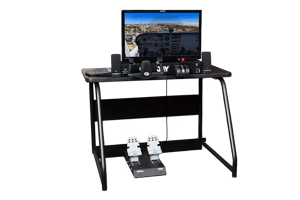 Guaranteed software compatibility
Guaranteed software compatibility- Quick and simple setup to start flying (with flight controls, speakers, and a monitor included)
- Ergonomic and appealing design
- Simplified communication about operating and troubleshooting your sim
- Competitive pricing
With a complete home flight simulator, the effort required to create a realistic flying experience already has been made for you. Assuming the device is high-quality, the flight modeling will be smooth, the position and feel of the flight controls will be realistic, and the display will be effective for visual and instrument flying. If you plan on using your flight simulator to help you get a private pilot license, improve or maintain your pilot proficiency, or just get you flying with minimal fuss, an all-in-one device could be the best home flight simulator setup for you.
With Redbird, the all-in-one flight simulator comes in a few different flavors.
The Redbird Jay
The Jay prioritizes getting the pilot flying in ten minutes or less. It’s an all-in-one desktop flight simulator with no peripherals to configure or systems to install. You simply put it on a table, plug it in, turn it on, and you’re flying in no time. The computer for the Jay comes standard with the following specs:
Computer Processor - Intel i5-8400, 6 Cores, 9M Cache, 2.80 GHz up to 4.00 GHz
Computer Memory - 8 GB DDR4
Hard Drive Space - 250GB M.2 NVMe SSD
Graphics Card - Not applicable (on-board video)
Additionally, the Jay includes a 27-inch LCD monitor (1920x1080 pixels), Redbird’s professional-grade yoke system and “boat-style” controls for throttle and mixture, speakers, a keyboard with shortcut commands, Lockheed Martin’s Prepar3D software, and built-in flight scenarios.
For student pilots who are pursuing a private pilot certificate and pilots and home sim pilots who want to get flying fast, the Jay provides an economical path to start flying without the time and effort otherwise required to build a realistic home flight simulator setup.
The Redbird Jay Velocity
If you want even more computing power, the Velocity edition of the Jay upgrades the CPU to an Intel i7-9700, doubles the computer memory to 16 GB of RAM, and adds an NVIDIA GeForce GTX 1650 XC graphics card. Originally designed for public use, it also includes heavier-duty flight controls that hold up to repeated use by children and new sim pilots. The Jay Velocity runs both Prepar3D and X-Plane.
The Redbird TD and TD2
If you are a simulator pilot who wants to create an immersive flight training environment at home, the Redbird TD might be the all-in-one device that suits your flight simulation goals. In addition to computing power on par with that of other Redbird desktop devices, the TD features an avionics panel—currently either an analog six-pack or a G1000—that you can interact with during your flight training. With realistic buttons and knobs for the GPS and autopilot, the TD provides haptic feedback while you're flying.
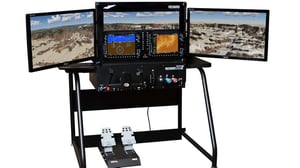 Unlike other desktop flight simulators, the TD has a unique mounting system that allows you to hang the device under a table, placing the yoke, switches, gauges, and visuals in the most realistic position for flying. The Redbird TD2 builds on the features of the TD and enables you to fly high-performance and/or complex aircraft.
Unlike other desktop flight simulators, the TD has a unique mounting system that allows you to hang the device under a table, placing the yoke, switches, gauges, and visuals in the most realistic position for flying. The Redbird TD2 builds on the features of the TD and enables you to fly high-performance and/or complex aircraft.
While their base prices—$7,999 for the TD and $8,999 for the TD2—likely exceed what a flight sim gamer wants to spend on a simulator setup, the Redbird TD and TD2 are among the best flight simulators to work on your private pilot training, instrument training, and instrument currency from home. Approved by the FAA as Basic Aviation Training Devices (BATD), the TD and TD2 allow you to log 2.5 hours toward your Aeronautical Experience Requirements, 10 hours toward your Instrument Rating, and complete all the tasks required for your Instrument Currency without an instructor present.
If you’re wondering whether a certified flight simulator like the TD or TD2 is the right choice for you, this article should help.
The Limits of a Complete Home Flight Simulator
For most home sim pilots, customization limitations are the downside to all-in-one flight simulators. Since the flight controls are part of the device, you generally do not have the flexibility to switch out your yoke (or flight stick) and throttle.
The same is true with your flight simulation software. To provide realistic flight modeling, complete home flight simulators generally run on a single simulation engine. That means that you are committed to one software platform and you will need to buy a new device to run a different one.
If you want to build a highly customizable home flight simulator, a desktop computer with separate flight control products probably is the best option. That way, you can configure your flight controls to your liking and fly Prepar3D, X-Plane, and Microsoft Flight Simulator 2020.
Questions?
We're happy to help. Give us a shout and we’ll help you find a home flight simulation solution that fits your goals.
Share this
You May Also Like
These Related Articles
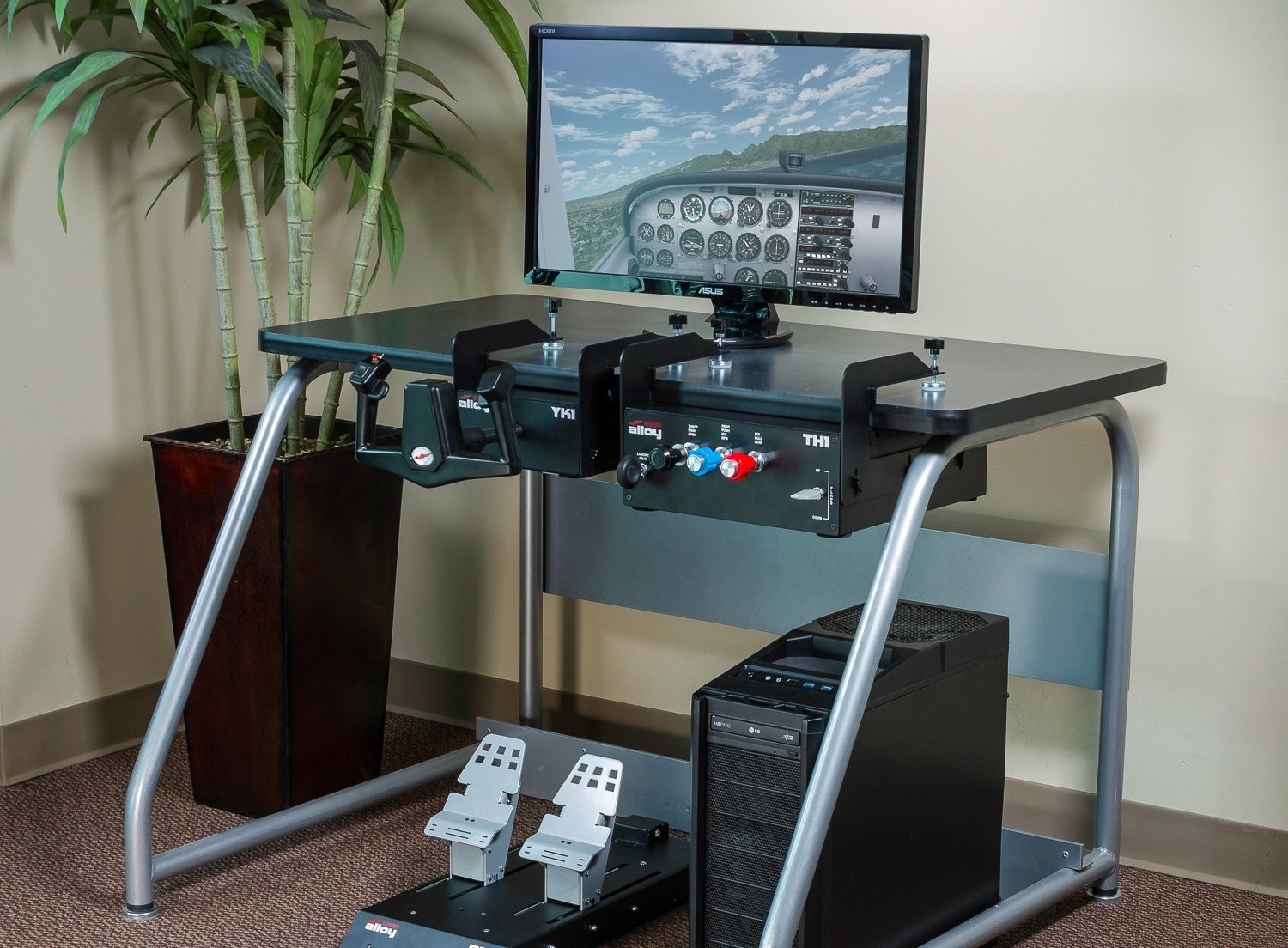
How to Set up a Home Flight Simulator
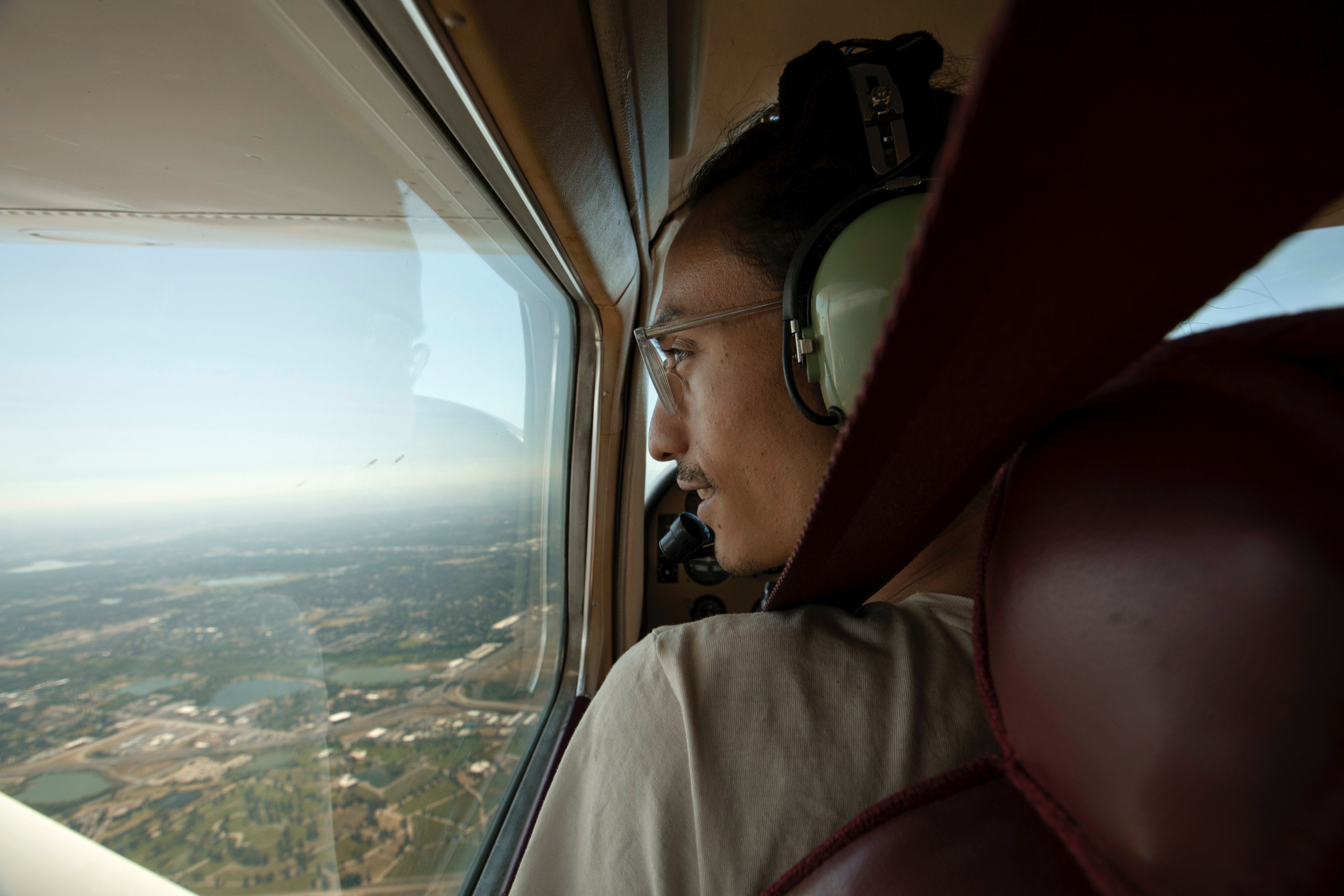
7 Steps to Save Money on Your Flight Training
-1.jpeg)

